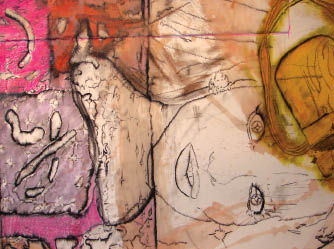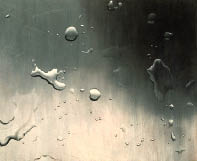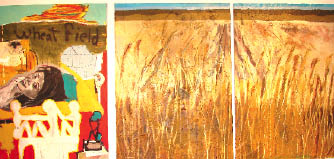Into the Biennial, Part 4
by Eric Jackson-Forsberg

The central gallery of the Castellani Art Museum features the work of three Beyond/In artists, all based in Western New York, but with a view to more universal issues of identity, whether personal, cultural or regional.
A.J. Fries’ paintings bring the world into sharp focus at both macrocosmic and microcosmic levels. But in doing so, they focus on the inherent detachment of representation, the literal lifelessness of a painting. Fries employs a muted, grayscale palette to represent the formal nuances of water droplets in Melted Snowflake, Window and Kitchen Sink. He also applies this narrow palette to landscapes and cityscapes such as Horizon and View, rendering them with the same hyper-analytic precision. Fries uses the plane of the painting as both surface and window, contemplating the surface-tension dance of water droplets on stainless steel or glass, as well as the quiet tableau of the city beyond. Even Fries’ image of an explosion, Bomb, has a quality of frozen contemplation, an image of extreme power and destruction represented instead for the sublime beauty of its exothermic flowering. In each of these paintings, Fries applies his masterful, photorealist technique, once reserved for his more lurid subjects like sex toys and Twinkies, to the elusive beauty of the mundane—the passing of a snowflake or the waterscape in a few square inches of a kitchen sink. These images offer melancholy but also enlightenment, the dual experiences propagated by the tension between banality and breathtaking detail.
The centerpiece of Fries’ wall is a work of a rather different sort. The Invisible Man takes Fries’ own image and enlarges it to an enormous, disembodied, smiling head. This gigantic visage is impressive at first glance, but all the more so when we realize what it’s made of: a variety of dark beers and wine on beverage napkins, each square panel pinned to the gallery wall in a matrix to form the image. It’s a boozy variation on Chuck Close’s signature technique, infused with whimsy and an adventurous exploration of nontraditional materials. It’s as if Fries took a barstool pastime to an expansive, obsessive extreme, and may have lost himself in the process. Though highly visible in its representation, the personality and individual essence of this invisible man is lost in an ephemeral series of assembled, tannin-stained paper.

The floating head of The Invisible Man stares directly at the opposite side of the gallery, an apt segue to the work of Kurt Von Voetsch. Von Voetsch’s Messbag Series presents an effluvium of layered images, replete with many mask-like “floating heads” of the sort that once populated various staff areas of the Castellani (a personal obsession and diversion for Von Voetsch). Masks have long been a tool in Von Voetsch’s performance bag of tricks, utilized not for their shamanic power, but for their flimsy potential for temporary transformation. With the Messbag Series, Von Voetsch asks us to consider the all-consuming artificiality of this age of masks—the artificiality of rhinestone-encrusted cellphone chatter, hyper-eroticized media and disposable yet insatiable identities.
The large drawings of the Messbag Series illustrate our contemporary culture of “more, more, more” through Von Voetsch’s graphically strong charcoal contours and deliberately obscuring swaths of wax. These transparent forms swim across and through one another like TV images in a constant state of market-driven velocity. Some of these images are autobiographical, drawn from Von Voetsch’s existing personal iconography (pigs, Bassett hounds, pseudo-anatomical sketches), but most are more universal icons of imbalanced cultural excess: toothy teen idols drawn from MySpace and fashion magazines, orgies of eating and drinking, leering faces caught between Miss America grins and maniacal grimaces, and meaningless, onomatopoeic words and text-messaging abbreviations (OMG!). All this is layered with a number of ornate curio cabinets, the decorative equivalents of the decadent human forms within and around them. Fittingly, Von Voetsch’s drawings have the linear quality of tattoos, but their forms also resemble intestines, as if the drawings are always in the process of digesting their contents.
The Messbag drawings are accompanied by two other elements: video documentation of a companion performance and an evolving, shrine-like installation. The video documents the artist’s attempts to promote his Beyond/In participation by handing out paper masks—faces taken from his drawings that also serve as exhibition invitations. A mime-like, masked trickster, Von Voetsch accosts a largely disinterested public standing outside the Albright-Knox Art Gallery and strolling down Elmwood Avenue, trying to make them accept a mask/invitation and pose for the camera. The exercise mirrors the process of self-fulfilling and self-propagating promotion, the modus operandi of reality TV. Some of the masks used in this performance are installed in the shrine area. This area includes an invitation to “Please bring in your messbag goodies,” and visitors have been happy to comply, creating a runaway installation of random, pop culture trinkets and more floating heads, an apt extension of the “messbag” theme. Even as I was perusing this part of the installation, a garland of paper onion rings was added to the mess. Von Voetsch’s mess bag grows like a malignant, deep-fried fix with no center…and no end in sight.

The third artist in the Castellani’s Beyond/In trio is Niagara County native Jay Carrier. Carrier’s two large triptychs juxtapose the natural beauty and identity of Niagara with its abject, industrial scarring. Two of the panels of Wheatfield represent a flattened, rural landscape, its naturalism heightened through the incorporation of real grasses, cattails and weeds. In the tradition of Kiefer’s symbolic landscapes such as Die Milchstrasse (Albright-Knox Art Gallery), this work relies on self-reflexive materials to produce iconographically-loaded texture. The third panel of Wheatfield provides sharp contrast to the landscape panels. This section is a graffiti-inspired collage of shopworn images resembling the found compositions of pasted-up posters that so intrigued the Dada artists. Carrier scrawls “Wheat Field” in black spray paint, but also jots a list of the Iroquois clans—wolf clan, turtle clan, snipe clan—as if trying to remember the prime symbols of his indigenous identity amidst such urban, commercial chaos.
The second triptych, Industrial Field, has a generally similar composition to Wheatfield, but this time Carrier explores the radically and irreversibly altered side of Niagara County through its industrial identity. The two landscape panels of this triptych show the deceptively green, manmade hills of the Niagara Falls landfill, superimposed with abstractions of the electrical towers of the Niagara power project. These hills are pushed down into the lower quarter of the composition by an apocalyptic expanse of gray-blue sky, and the whole composition is infused with a gritty aggregate apparently taken from the very wasteland depicted. The third panel, like that of Wheatfield, is an art brut collage of commonplace fragments (the Madonna, false teeth in a glass and a label from canned tomatoes). But this time, the white silhouettes of two dancing figures dominate the scene, apparitions suggesting traces or memories of life. Superimposed on this is the text “when the sky turns black carbon,” etc., and, in the very center, “I’m OK.” Such an affirmation does little to comfort the viewer in the face of this powerful vision of industrial degradation, one that constantly threatens to undermine the rich cultural and natural identity of Niagara County.
|
Issue Navigation> Issue Index > v6n43: Halloween (1/25/07) > Into the Biennial, Part 4 This Week's Issue • Artvoice Daily • Artvoice TV • Events Calendar • Classifieds |









 Current Issue
Current Issue